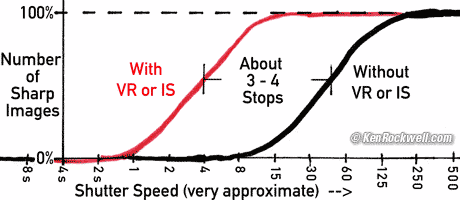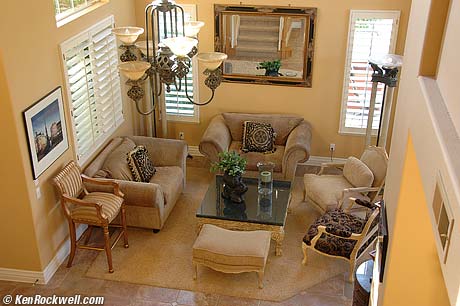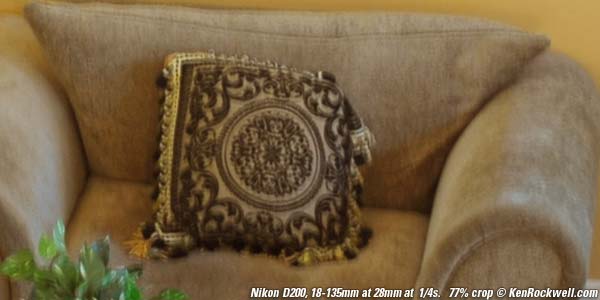Home Donate New Search Gallery How-To Books Links Workshops About Contact
Why IS and VR Matter
© 2010 KenRockwell.com
I
get my goodies at Ritz, Amazon and Adorama.
It
helps me publish this site when you get yours from those links, too.

Percentage of Sharp Images vs. Shutter Speed.
(Photo examples follow)
Written 2006, renewed June 2010
|
I personally suggest Adorama, Amazon, Ritz, B&H, Calumet and J&R. I can't vouch for ads below.
|
Introduction
I'm addicted to Canon's IS (Image Stabilization) and Nikon's VR (Vibration Reduction). They help me get much sharper images with long lenses, and with all lenses in dim light.
IS and VR are so important to helping me get great shots I won't buy a lens or camera without it, given the choice.
As I'll show shortly, even a point-and-shoot with IS is sharper than an expensive DSLR camera without IS in some conditions.
VR vs. IS
VR (Nikon) and IS (Canon) are the same thing. I'll use both terms interchangeably. Each maker uses their own acronyms.
Each stabilizes images from the jiggly effects of hand-holding. It helps replace a tripod for making sharp photos. IS and VR let me shoot in bad light and forget a tripod, except for the most formal night shots.
IS and VR work great for subjects that hold still, which is most of what I photograph. VR doesn't do anything for subjects that are moving, like sports and kids.
Some folks like to use VR and IS to help get better motion panning shots, in which case the VR stabilizes one direction while the other is blurred.
To reduce the effects of subject motion you still need to use faster lenses, more light, or a higher ISO.
VR only helps reduce camera motion; it can't do anything to stop subject motion.
Other Makers
Minolta, Panasonic, Olympus and Sony
Minolta (now Sony) makes DSLRs which move the sensor to counteract camera movement. I have not tried them. An advantage is that they claim to work with all your lenses, since the VR is in the body, not each lens.
Anti-Shake
Beware the phrase "anti-shake." Most of the makers who use this term are cheating and merely boosting the ISO to get faster shutter speeds. You can set higher ISOs yourself. These cameras usually do nothing to counteract camera motion as IS and VR do.
How IS and VR Work
I'll skip the details, but real IS and VR use motion sensors to detect motion before, and then during the exposure of the photograph.
They then use various devices to shift the optical image (or move the image sensor) to counteract this motion.
They ensure the image stays more stable during exposure.
You can see them work through the viewfinder (Nikon and Canon SLRs) and on the LCD (Canon compacts).
The Gamble and the Graph
Hand jiggling, also called tremor by doctors and vibration by Nikon, is random.
Make enough photos in any condition and some will be sharper and some will be more blurry. The percentage depends on the conditions, shutter speed and focal length.
The graph shows how your percentage of sharp shots increases with shutter speed. At very long shutter speeds, like 30 seconds, you will almost never get sharp photos hand-held, regardless of having VR or not. It's never 0.00%, shoot enough and you might get lucky and get a sharp one, even at really long speeds.
At fast speeds, like 1/1,000, you'll get sharp shots almost 100% of the time, again regardless of having VR or not. Again, almost 100% isn't 100%. Make enough shots at high speed and you may get an unsharp one, too, and VR will also improve this percentage for you.
This all comes down to probability and statistics. There are mathematicians who explain this better. Because this is due to chance and random probability the results can and will vary each time.
This graph shows how makers come up with their "stops of improvement" claims, depending on how their system performs.
The exact shutter speeds and shape of the curves all depend on you, your surroundings and the focal length. The graph is hand-drawn to illustrate what VR does and doesn't do.
The old wives' tale about using at least 1/30 or at least 1/(focal length) comes from a general observation that for most people, you'll get about 50% sharp shots at that speed. That's the middle of the black "no VR" curve. Being a random function, faster speeds will give a larger percentage of sharp shots, and vice-versa.
Trick
Since we're playing odds, I always stack things in my favor by using a camera's Continuous shutter mode and holding the shutter down to make several shots. I pick the sharpest later. As the shutter speeds get slower and the lenses get longer, I make more and more shots. For instance, if I'm under a condition that might give me sharp shots 10% of the time, I'll make 10 or 20 shots and pick the winner. This works!
Likewise, this is why you can get blur from camera movement even at 1/250 second with a normal lens. The odds are that every so often you'll get a loser. If it's critical, make a couple of shots to be sure.
VR or IS always improve my odds. There are no hand-held conditions where I've seen it make things worse.
Where VR Shines
VR and IS give huge improvements in the sweet spot where the two curves separate. Shoot at about 1/2 - 1/15 of a second with normal lenses and you'll see the biggest night-and-day difference. Shoot faster and both are sharp, shoot slower and even IS gets blurry.
Examples

Guide image from which crops are taken.
Here's my 10MP D200 with my 18-135mm non-VR lens compared to my 6MP D70 with 18-200mm VR lens. I show the D70 at 100% magnification, and the D200 at a little less so they match.
Roll your mouse over the image to see the other image for comparison.
Roll your mouse over this to compare my D200 without VR lens to my D70 with VR lens.
Now can you see one of the many reasons I suggest a less expensive body and better lens? Remember that lenses are useful for about 5 - 10 years, while digital bodies go obsolete each year. The less expensive D70 / 18-200mm VR combo is much better hand-held at slow speeds than the much higher resolution D200 without a VR lens.
Of course these are shot at 1/4 second at 28mm where VR makes a big difference. At much higher speeds it doesn't make a difference, but it does make a difference, even in direct sunlight, at 135mm.
How about this. Roll your mouse over to see the difference:
Roll your mouse over to compare my D200 without a VR lens to my Canon SD700 pocket camera with IS.
IS and VR are the keys to sharp shots at the exposure times typical of indoor and available light shooting. In the real world, even a tiny point-and-shoot with IS can run rings around a 10 MP DSLR without VR when the light gets dim and you don't have a tripod.
For each shot I made six shots. With VR or IS, five or six shots were this sharp. Without VR or IS, five or six were this blurry. I made that many shots to ensure what I show is representative. If you make enough shots you can eventually get a blurry IS shot and clear shot without.
Sorry the sizes and exposures don't match perfectly. Pocket cameras only zoom in steps so I got it as close as I could without resizing images as I had to for the DSLRs. The SD700 is a 6MP camera. Oddly the pocket camera looks even sharper than the D70: the pocket camera uses more default sharpening internally and wound up having more contrast after I quickly matched the levels.
Tripods
I usually turn off VR on a tripod; it's not needed. If I leave it on, I've never seen a problem either.
Many VR systems are smart enough to figure out if you're on a sturdy tripod and deactivate themselves; but if you're in the wind or the tripod is otherwise unstable, VR and IS will help.
Very Slow Shutter Speeds (several seconds)
If the speed is a few seconds and I'm hand-holding, VR and IS usually improve things, even if the results still aren't perfect.
Frequency Ranges and Applications
Vibration, in engineering terms, is measured frequency and amplitude.
VR and IS systems are able to handle vibrations only in certain ranges.
The frequency range of interest is about 0.3 Hz to 30 Hz.
IS and VR systems are designed to ignore very low frequencies of vibration because these systems would mistake panning or reframing for vibration, and would try to work against us as we tried to shoot.
Frequencies higher than about 30 Hz aren't particularly important. Our muscles don't wiggle faster than 30 Hz, and external vibrations at higher frequencies are filtered by the combination of our bodies and the mass of the camera.
Never place your camera directly against something that's vibrating; hold it in your hands to prevent the highest frequencies from being transmitted to your camera.
Above a certain amplitude range (strength of vibration), the mechanics of the system can't move far enough to counter really huge whoop-de-doos, for instance, if you're shooting from a moving platform like the back of a horse.
Active versus Normal
If you have these controls, they optimize the system for different frequency and amplitude ranges appropriate to that kind of shooting.
Active usually lets the system correct for larger swings that otherwise it would ignore, presuming instead that you were trying to reframe.
I've never seen any performance differences, and usually shoot in Normal, unless I'm shooting from something that's moving, in which case often the VR system often can't handle it anyway. I will shoot in Active as needed, but it doesn't do much.
Aircraft
VR systems are for eliminating hand tremor, not for shooting from the backs of moving cars or out of helicopters. These much larger vibrations usually require different kinds of external gyro stabilizers.
When shooting from aircraft, never brace a camera against the door or any other part of an aircraft. Instead, hold the camera in your hands and sit straight up with your shoulders away from a seat, so your body can absorb as much of the vibration and buffeting a possible.
As with everything, try your equipment in your situation and see what looks best. When I've shot from open windows of small aircraft, Nikon's VR system couldn't handle it, which makes sense, because it's not designed for that.
Very Fast Shutter Speeds (1/1,000)
VR and IS work great at fast speeds, especially with long lenses where we're likely to see a difference.
We can see sharpness better and more easily today with digital than we could on film. If an image is even slightly blurry, it's easy to see on a digital shot, but often went unnoticed on film.
Thus, shots even at 1/1,000 with 300mm lenses can be improved with VR. I use VR all the time.
Even though VR systems don't respond to the highest frequencies of vibration, these vibrations have never been the problem with fast shutter speeds.
The problem at fast shutter speeds is the same as at slow speeds: vibration in the 0.3-30 Hz range. Fast shutter speeds let us reduce the vibration, which is why VR isn't often important at fast shutter speeds, however with long lenses that have always magnified the vibration along with the subject, VR and IS are extremely useful.
With shorter lenses at high speeds, vibration hasn't been an issue, however VR and IS will improve things if there is any possible improvement to be made hand-holding.
Even though high-frequency vibration isn't an issue with VR or IS at any shutter speed, the usual 0.3-30 Hz vibrations are magnified by long lenses and are what's reduced with VR or IS at fast shutter speeds.
Failures
VR and IS systems can break in weird ways. If they do, turn them off until you get it fixed.
My first Canon 28-135mm IS lens had a subtly defective IS system. It was devilishly defective in such a way that it worked great at slow speeds, but made daylight shots at faster speeds worse!
I sent it to Canon under warranty, and Canon quickly replaced the IS system, and it came back perfect.
This is why I always test my lenses as they arrive. Shoot with and without VR or IS, and learn at what speeds and focal lengths you get perfect results. This way you can shoot accordingly in the field, or catch the rare factory defect.
No VR or IS system even makes things worse, unless it's broken. I've never had a problem even if I've left VR ON on a tripod.
Recommendations
IS and VR are critical to sharp hand-held images up to about 1/60 second with normal lenses, and up to about 1/500 with telephoto lenses.
At exposures of more than a few seconds IS and VR are less help, but still better than nothing if you have no tripod or can't rest the camera on something solid.
VR also can help even the highest speeds with long lenses.
Personally my best shots are grab shots made outdoors in fading light. Therefore I LOVE VR and IS!
I always leave VR and IS on, except if on a very sturdy tripod. I use it on monopods, too
Help me help you top
I support my growing family through this website, as crazy as it might seem.
If you find this as helpful as a book you might have had to buy or a workshop you may have had to take, feel free to help me continue helping everyone.
If you've gotten your gear through one of my links or helped otherwise, you're family. It's great people like you who allow me to keep adding to this site full-time. Thanks!
If you haven't helped yet, please do, and consider helping me with a gift of $5.00.
The biggest help is when you use any of these links when you get anything. It costs you nothing, and is this site's, and thus my family's, biggest source of support. These places always have the best prices and service, which is why I've used them since before this website existed. I recommend them all personally.
Thanks for reading!
Ken
Home Donate New Search Gallery How-To Books Links Workshops About Contact




